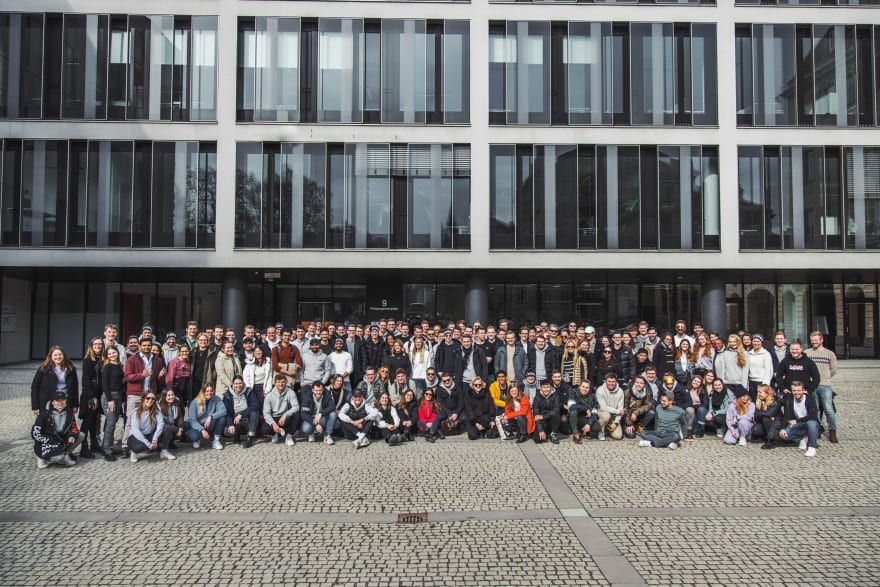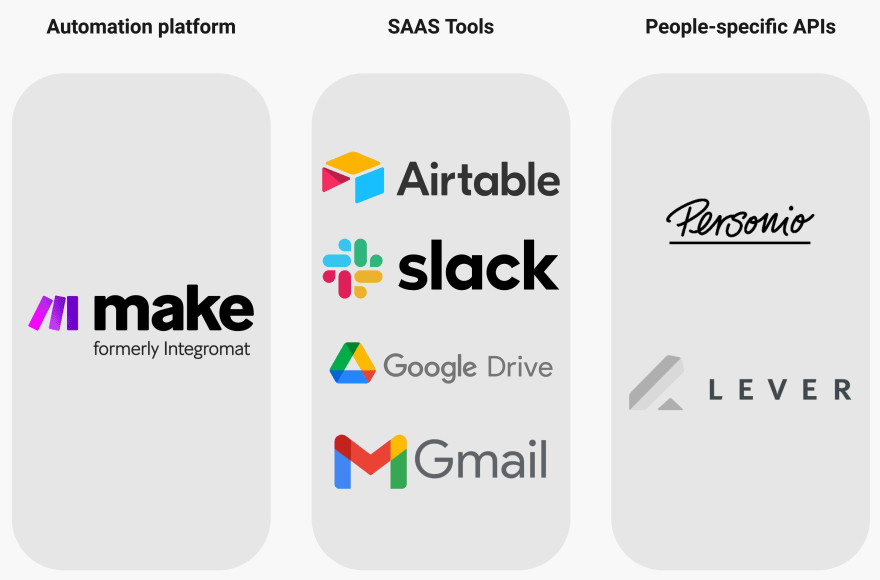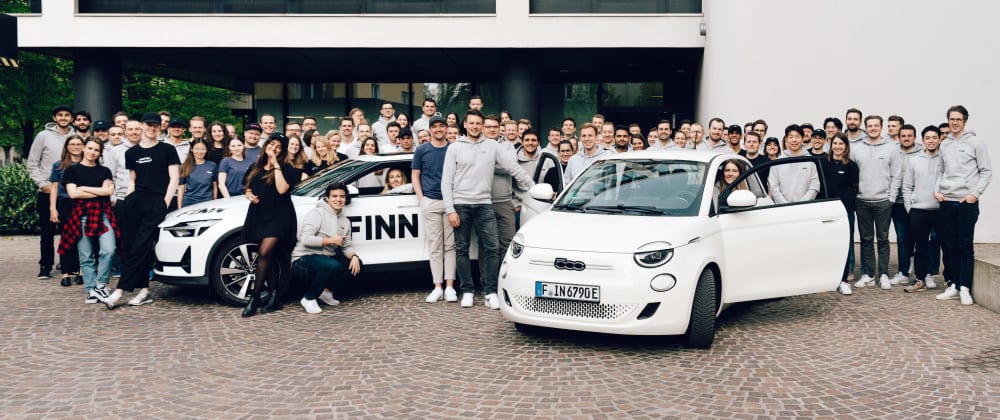About FINN
FINN is a start-up founded in 2019 in the German automotive hub of Munich, that aims to make mobility fun and sustainable through our car subscription service. Like many other start-ups, we have BIG goals – to be the most popular car subscription company in Europe and the US.
Having a great product is one thing, another thing that is imperative to a company’s growth is the people. A promising company attracts promising talents. FINN has grown immensely in the last few months – when I first joined in September 2021, we were slightly over 150 people and now 9 months later, we have more than doubled to 340 people.
 The FINN Team in 2022
The FINN Team in 2022
In the beginning…
A year ago, we were welcoming less than 10 people into the company each onboarding cycle and it did not take much to do most of the onboarding tasks manually, like adding new hires onto our personnel database platform or creating their Google accounts one by one.
As a growing company, FINN has always made recruiting a priority. Our successes in recruiting lead to a substantial increase in the number of new joiners in each cycle. Currently, we are onboarding 20-40 people every month. This meant that the 20-minute onboarding preparation turned into a two-hour-long blocker on our calendars. Plus we could miss people or information out. We realized that this increase in new joiners made it necessary for us to work smarter to keep up.
And our solution for that is No-Code automations.
Tools of our trade
No-Code (or Low-Code) is not foreign to FINN, as it plays an integral part in building our product. Currently, 60% of our processes run automated and we are focusing to increase this share even more. Make.com (formerly known as Integromat) has been a constant in the company. Working with SAAS tools available as modules on Make like Airtable, Google Workspace and Slack, as well as APIs from Personio and Lever, the People team began automating.
 Tools for our HR automations
Tools for our HR automations
With the intent of increasing the volume of automated workflows, we also kicked off a new role, aptly called Business Development Manager – Automation, at the end of last year to find people to own our automations and expedite the creation of future ones.
Opportunities and obstacles
The first step into no-code automation is undoubtedly difficult. With little knowledge of the tool, we found ourselves often making scenarios that are not fool-proof, simply “to make do for the time being”. Moving forward, we would need to dedicate time to streamlining our automations, making sure that they are reliable and able to handle special cases as much as possible. At the same time, we need to ensure that the APIs we use are transferring the correct information consistently by giving the right amount of access to these APIs. Without prior experience in creating automation or developing anything tech-related, it does get difficult to see solutions to errors beyond the basics and when the basics fail, we run to the engineers.
But here’s the good news: No-code is for everyone.
The learning curve isn’t extremely steep – you don’t need to learn a whole new language to get started. You can always start small, pick up know-hows at your own time and own target, and use them to refine and streamline. And FINN has been preaching this good news from the beginning by including an introduction and FAQ session for Make and Airtable into our onboarding process for everyone – regardless if you are working in the Tech or the Business side. Be it to create automation to wish people a “Happy Birthday” on Slack or to remind people to update meeting slides, there are always simple ways to innovate with no-code tools to increase productivity in day-to-day tasks and make FINN a better place to work at.
The start of our automation journey
The People Team has been utilizing the functions of our HR Information System (HRIS), Personio, and our Applicant Tracking System (ATS), Lever, since the very beginning. One useful function would be creating templates for contracts, reference letters and other documents, as it decreases time in creating employee-specific documents and allows for data used for automations to be extracted in a fairly organized manner. Other than that, Personio and Lever also enabled automatic emails, and we used this to, for example, send out a pre-boarding email with information about the first day or a survey about the application process.
My personal journey in creating automation didn’t start with a grandiose workflow and a lofty plan to overhaul the whole People department – it began with a Make scenario with 2 modules. The idea behind it was to send a notification to our Community Manager, Maya, every time someone submits a form to indicate their preference in equipment they will receive when they start. So all it took was a Webhook from Airtable, a Slack module to create a new message and finito.
The big leap
Combining Make and Personio’s API became the bread and butter of most of our automations. With this connection, we created an automated Onboarding Overview, a huge Google Sheet document listing all incoming employees, sorted by the month they were starting. Automating input into this huge document saves time and allows for extensive information to be presented at a glance that the People Team would need to prepare for onboarding. Furthermore, it gives information to supervisors, IT administrators or account owners for our tools on our new starters and helps us to provide an even better onboarding experience by thorough preparation. After a couple of revisions, we ended up with a scenario consisting of not 20, not 30, not even 40, but 56 modules (though it probably could’ve been lesser, if we weren’t so novice). To date, this was probably the largest automation the People team has ever seen.
 How People automation started and what it grew into
How People automation started and what it grew into
Moving forward
As mentioned above, we need to constantly think about how we can improve older automations. With more hands-on experience, we start to collect more knowledge about the functionality of our tools. For example, we recently migrated the Onboarding Overview to Airtable from Google Sheets as we realized that Google Sheets modules don’t update information as well as we hoped it would. Moreover, we could work with lesser modules in our new Make scenario.
Of course, no-code automation in the People department doesn’t always need to be grand and elaborate, it can definitely be sweet and simple. Many of the automation that have been created recently served relatively simple purposes. For example, we have a workflow that creates a Slack reminder for new joiners to introduce themselves to the team and another one that adds interns into a specific channel. These workflows can also be set-up easily without having no-code tools or extensive knowledge in software engineering in place.
As you can see, no-code automation has helped the People team bridge gaps in productivity – regardless how big or small – as we grow as a company. With new automated workflows being created consistently, more and more people have started to see the possibilities and pitched in their ideas for future automations. Creating an automation backlog and working through them slowly but surely will help the team be able to focus on other important tasks as we scale.

TL;DR No-code automation has helped to save so much time in the People department and brought out many great ideas. Best part is: anyone can do it. Start small, dream big.
And if you want to be a part of FINN’s automation journey, you should check out the position of Business Development Manager for Automation or join our Women in Tech squad in the Engineering, Product or Data team.
This article was written by Greta Etheldra.
